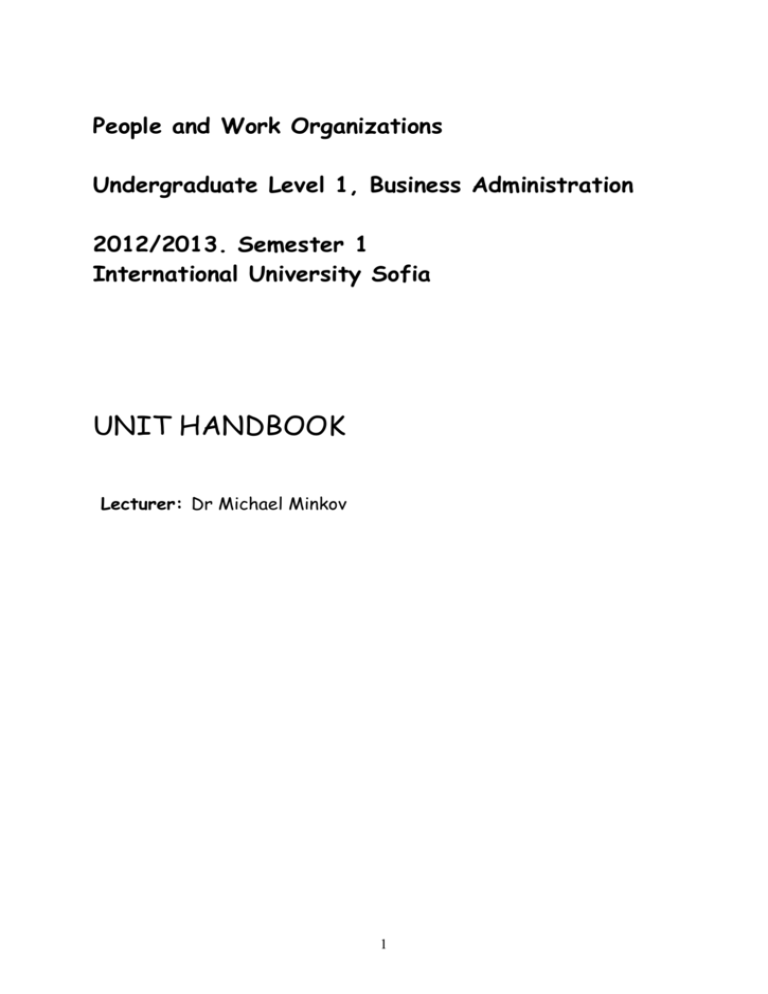
People and Work Organizations
Undergraduate Level 1, Business Administration
2012/2013. Semester 1
International University Sofia
UNIT HANDBOOK
Lecturer: Dr Michael Minkov
1
1. Aims of the Unit.
The stated aims of the unit are as follows:
To introduce some of the main concepts and topic areas of organizational
behavior.
To encourage students to reflect on their own perspectives on, individual
and organizational behavior and explore this within the context of
effective management and the achievement of individual and
organizational goals.
2. Learning Outcomes.
On successful completion of the unit you will be expected at threshold (pass)
level to be able to:
Demonstrate broad knowledge and understanding of the nature and
context of working and managing in organizations.
Understand and evaluate a range of theoretical and conceptual
frameworks used in the analysis and discussion of people, work and
organizations.
Explain and evaluate some contemporary issues in managing work and
organizations and identify the implications of these for managers, other
staff and organizations.
3. Unit Assessment.
1. A 1.5 hour closed-book examination. The examination will take place during
the regular exam session at the end of the school year. It is weighted at 50%
of the total unit mark.
You will have 4 exam questions. You have to choose TWO of them and write
short essays on each question (about 800 words for EACH essay).
2. An individual essay to be completed and submitted by the end of the first
week, after classes resume in January, 2013. It will account for 20% of your
total unit mark
2
Essay titles (CHOOSE ONE):
1. Personality differences and their implications for work
organizations
2. Globalization and its effects on organizations and their employees
around the world.
The upper word limit for your chosen essay is 1500 words. Exceeding this limit
by more than 10% will incur a mark penalty.
Note that this is an individual assignment. Collusion is classed as an assessment
offence and will be dealt with accordingly.
Your essay should be referenced according to convention. Do not run the risk of
being accused of plagiarism due to incorrect referencing. Refer to university
guidelines on this issue and if in doubt ask your seminar tutor. The lecturers
who mark your essay will want to be sure that you have understood the topicmerely reproducing work from other sources does not demonstrate any such
understanding! Use the Harvard method of referring to published work. List
references at the end of your essay in alphabetical order by author’s name.
General format of a book reference is shown below:
French, R. (2007), Cross-Cultural Management in Work Organisations, London:
CIPD.
The appropriate format of a journal reference is as follows:
Fang, T. (2003), A critique of Hofstede’s fifth national culture dimension,
International Journal of Cross-Cultural Management, 3 (3), 37-368.
Make sure you refer to book and journal articles as your main sources. You are
likely to refer to websites too but do not make websites your main point of
reference-this is regarded as poor scholarship and will depress your mark.
3
3. An in-class individual presentation on ONE topic, lasting 15 minutes: 20% of
the total mark. Presentation topics and presentation dates will be assigned to
each student through a public lottery. The topics are provided below.
Presentations must be accompanied by an 800-word written summary, covering
the main points of the presentation. The submission day and time for the
summary is that assigned to each student for the presentation. Failure to
submit a summary by the time the presentation is scheduled to start will result
in a mark of 0 for this assessment element. The summary must be in essay form,
fully referenced Harvard style. The reference list must contain no less than 10
academic sources all of which must occur in the text of the summary.
Presenters must make a real presentation rather than read their summaries or
other texts to the audience. The only aids that presenters are allowed to use
during the presentation are the slides that they are showing to the audience.
The use of any other aids (including a copy of the summary) will result in
disqualification from this assessment element and a mark of 0 for it.
Presentation Topics:
1. General Intelligence and Emotional Intelligence
2. Human Personality
3. Work Motivation
4. Perception and Perceptual Distortions
5. Stress and Ways to Deal with It
6. Globalization: A Blessing or a Source of Evil?
4. Class participation and contribution: 10 percent of the total mark.
4
4. Reading and Other Source Material.
The main text referred to in this unit is:
French, R. Rayner, C. Rees,G. & Rumbles,S. (2008), Organizational
Behaviour, John Wiley & Sons. ISBN: 978-0-470-51106-0.
Other useful handbooks are:
Mullins, L.J. (2007), Management and Organisational Behaviour, 8th
edition, FT Prentice Hall, ISBN: 978-0-273-70888-9, provides a
managerial approach to OB and is encyclopaedic in scope. The book
includes contributions from Portsmouth lecturers and may also be
referred to in other units later in your degree.
Robbins, S. & Judge, T. (2008), Organizational Behaviour, 13th
edition , Pearson Prentice Hall, ISBN: 978-0-13-207964-8.
5. Syllabus
The nature of OB as an academic discipline
Individual differences
Differences in intelligence
Differences in personality traits
Group differences
Gender differences
Social and cultural differences
Perception
The nature of human perception
Perceptual distortions and methods for dealing with them
Motivation, job satisfaction, and job design
5
Content theories of motivation
Process theories of motivation
Job satisfaction factors
Job design
Stress
The nature of stress
Stress-inducing factors
Dealing with stress
Globalization and its implications for companies and societies
6









